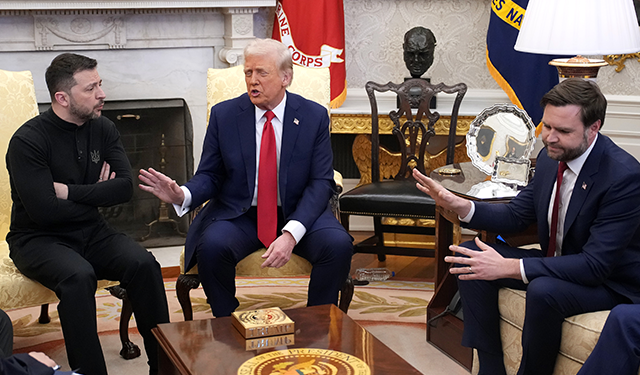📈 Friday’s Market Rally: Stocks Soar Despite Zelensky’s White House Showdown
Wall Street closed the week with a bang, shaking off global uncertainty and roaring to strong gains. Despite a rocky start—fueled by tensions between President Donald Trump and Ukrainian President Volodymyr Zelensky—investors ultimately saw reason for optimism, pushing stocks higher across the board.
The S&P 500 climbed 1.59%, the Dow Jones Industrial Average surged by 601 points (1.39%), and the Nasdaq Composite posted a 1.63% gain, rebounding sharply from its earlier slump.
So, what happened? Let’s break it down.
Zelensky’s White House Visit: A Diplomatic Stumble?
Tensions ran high when Trump and Zelensky met at the White House, where Trump reinforced the U.S. stance that a negotiated settlement with Russia was the best path forward. Zelensky, however, had hoped for stronger U.S. security guarantees—and when it became clear that wasn’t happening, he walked away empty-handed.
Adding to the drama, a potential mineral-rights deal, which could have secured deeper economic ties between Ukraine and the U.S., fell through in the process. This uncertainty initially rattled investors, causing a midday dip in the markets.
But Wall Street quickly shrugged it off, as investors interpreted Trump’s firm negotiating stance as a sign of strength and stability, rather than chaos.
Read More: Zelensky’s Washington Trip Ends Without Security Guarantees
‘Fortress North America’ – U.S., Mexico, and Canada Eye Tariff Unity
While tensions played out in Washington, a major trade realignment was taking shape behind the scenes. Mexico is pushing for stronger tariff policies against China, and U.S. Treasury Secretary Scott Bessent revealed that Canada may soon follow suit.
The idea? Create a “Fortress North America” by aligning tariffs across all three nations, making it harder for cheap Chinese imports to flood the market.
“It would be a nice gesture if the Canadians did it also,” Bessent told Bloomberg. “So in a way, we could have Fortress North America.”
Mexico has already started negotiating higher tariffs on Chinese-made cars and auto parts, an industry heavily reliant on Chinese manufacturing. Trump has long argued that China uses Mexico as a backdoor to bypass U.S. trade restrictions, undercutting American industries.
Canada, on the other hand, has already imposed tariffs on Chinese electric vehicles, steel, and aluminum but has yet to expand restrictions on semiconductors, solar panels, and critical minerals—something that could become a bargaining chip in upcoming trade talks.
The move marks a potential shift in global trade alliances, reinforcing North America’s economic ties while further isolating China’s influence in the Western Hemisphere.
Related: U.S. Eyes Tougher Tariffs on Chinese Imports
Inflation, Interest Rates, and the Fed: No Easy Cuts Ahead
The latest inflation report threw a curveball at investors who were hoping for interest rate cuts from the Federal Reserve.
The numbers? Core inflation rose 2.6% year-over-year in January—a slight improvement but still well above the Fed’s 2% target. That means no immediate rate cuts, despite Wall Street’s persistent hopes.
At the same time, investors piled into government bonds, driving down yields. Some analysts believe this signals caution about the economy, while others see it as confidence in America’s ability to navigate shifting trade policies without spiraling into recession.
More: Will the Fed Hold Off on Rate Cuts?
The Market’s Verdict: Confidence in Trump’s Tough Stance
By the end of the day, investors made their position clear:
✅ They’re not rattled by Trump’s firm stance on Ukraine.
✅ They see a stronger North American trade alliance emerging.
✅ They trust that prioritizing U.S. interests leads to more stability, not less.
Zelensky may have walked away from Washington with diminished leverage, but Trump’s refusal to be pressured reinforced his negotiating power. Meanwhile, Mexico’s willingness to align with U.S. tariffs suggests a major shift in North American trade policy—one that could put more economic pressure on Beijing.
In short, markets liked what they saw: a White House that won’t be bullied, a more unified trade front against China, and an economy that remains resilient despite global uncertainty.
📌 Stay Updated: The Latest Market & Trade News
💡 What do you think? Will the U.S., Mexico, and Canada fully align on tariffs? Is Trump’s approach to Ukraine the right move? Hit Reply and share your thoughts!
✉️ Enjoyed this update? Forward this email to a friend!
🚀 Until next time,




















